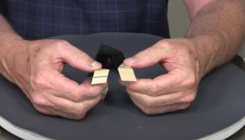Somehow I feel like you guys are arguing two different things - I am in Jerry's corner from experience what he means is if you take a 1" x 3/4" thick board and lay it down flat (1 inch side being face grain) and cut wedges as in like /\ triangle shaped , if you do not get a very precise exact angle for each segment when you put them together to form a ring, you ARE gonna have a gap between the last 2 segments - only way to fix is assemble half rings and flatten faces to mate flush Alternating the pieces does help offset slight (I mean hundredths of a degree) variations in your segments , assuming your sled is actually set to an accurate division of 360 degrees - I had perfect angle set on my sled, and yet due to loose tolerances in table saw (miter slot variations allowing sled to wiggle in some spots) stacked with wood that likes to move (oak) and thin kerf saw blade that wasn't as sharp as it could be, my first ring ended up with a gap (only .002, but in a wood turning, that is glaringly visible!) so for my second ring, I did as Jerry's video suggested, made a line on one face and then alternated my segments for second ring, ended up with just a hair (if even that) of a gap - couldn't quite see it but could catch edge of a sharp chisel in the gap. - with no difference in sled setup on saw.
So, upshot is I agree with Jerry - those little ever-so-slight variations will stack up - the more segments you have, the worse the gap. So the argument Jerry (and I) are making is not gaps between rings, it is gaps IN the rings segments. In many cases if you are working with top of the line equipment and very tight tolerances on your setup, you might not have any gaps at all doing it your way, so I see your point, but your argument seems based on having precision setups from the get-go , while Jerry's argument is towards the lower range of precision and care of set-up - doing it Jerry's way , the "newbies" and folks like me with less-than-premium equipment can still achieve nice gap-free rings with a lot less effort.

















